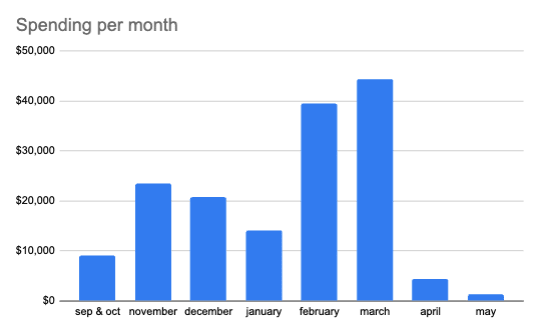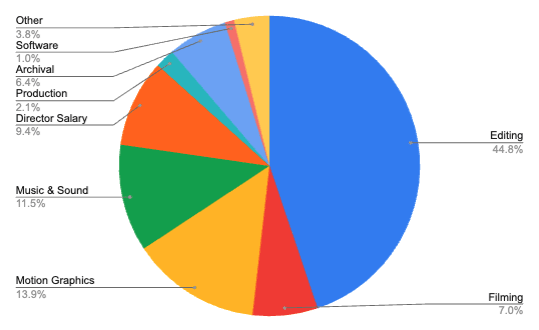Published on August 1, 2025 9:42 PM GMT
Below some meta-level / operational / fundraising thoughts around producing the SB-1047 Documentary I've just posted on Manifund (see previous Lesswrong / EAF posts on AI Governance lessons learned).
The SB-1047 Documentary took 27 weeks and $157k instead of my planned 6 weeks and $55k. Here's what I learned about documentary production
Total funding received: ~$143k ($119k from this grant, $4k from Ryan Kidd's regrant on another project, and $20k from the Future of Life Institute).
Total money spent: $157k

In terms of timeline, here is the rough breakdown month-per-month:
- Sep / October (production): Filming of the Documentary. Manifund project is created.
- November (rough cut): I work with one editor to go through our entire footage and get a first rough cut of the documentary that was presented at The Curve.
- December-January (final cut - one editor): I interview multiple potential editors that would work on the final cut, and decide on one candidate who would be the one that does most of the editing (from December to February).
- February-March (final cut - 7 Full-Time Equivalents): I work with a total of 7 seasoned professionals (working full-time) to have a finished documentary by the end of March. This is the most capital intensive period of the post-production phase.
- April: We wait back to hear from multiple distributors about whether they would be interested in publishing the documentary on their platform. Multiple outlets show strong interest (New York Times Op-Docs or Wired) but the content of the documentary doesn't fit publication policies.
- May: The documentary is published on May 5th.

Breaking down how the money was spent:
- Editing was the largest part of the expenses, since I ended up paying for a total of 4 different editors, that have worked from November to March included. From February to March I had multiple editors working on the documentary in parallel.
- Motion graphics was the second largest item, with two people working on motion graphics in February and March
- In terms of music & sound, the documentary used custom music made by a composer, with some of the songs played by real instruments, but also required the work of a seasoned sound mixer, which is why this is the third most expensive item.
- The director salary ended up representing only ~9% of the total expenses, since I had originally planned to pay myself $15k for 10 weeks, but the project ended up taking ~27 weeks instead.
But why did the project end up taking 27 weeks instead of 6 weeks?
Short answer
I ended up getting more funding than I originally had asked for on Manifund, and had to hire many different professionals with that funding. Having to present something intermediary at the conference "The Curve" potentially slowed us down. And a lot of the steps had to happen one after the order, including all of the fundraising, hiring, multiple steps of post-production, on top of the distribution of phase where we had to wait to hear back from potential distributors. All of this considered made that the movie take ~5 months to be ready (and 6 months to be out) instead of 6 weeks.
Long answer
- In November I was offered to do a first screening of the documentary at the AI conference The Curve, which I imagined to be a great way to present a first draft of the movie as we were working on it. However, in order to get this first draft done on time (for the conference), I had to hire an editor with whom I did not end up working with throughout the project, and most of the work was rushed using a software that we did not use in the future, meaning a lot of the work we did in November was not directly re-usable in later months.In December a lot of time was spent trying to find a film editor that would be willing to work full-time with us on the project. In the end I was really satisfied with the editor we ended up with, but then came the end of year Holidays, so not a lot of editing happened then. On top of that, our funding was constrained enough that I would not have been able to hire more people to work on this, which would make my only editor much less productive compared to other environments where he would have an assistant editor, an archival producer or motion graphics person to help him.In January, an important bottleneck was still not being able to hire more people because of funding constraints. But also the wildfires happening in LA, which directly impacted our main editor. When funding was secured, a lot of time was spent finding the right people that would join in February, including a composer, an archival producer, two motion graphic designers, and two editors. Some other things that slowed us down here was that the software and organisation decisions we had taken in earlier months were starting to slow us down, so had to do some large refactoring, and transition software.In February most of the editing for the documentary happened, with 7 people working full-time on it. By the end of the month, we were able to have something that was almost done in terms of story and bytes.In March most of the music, motion graphics and sound happened, because all of this work required the edit to be locked-in (also called "picture lock").In April the movie was ready to be published, but we spent most of the month waiting for the potential distributors (NYT, Wired, LA Times, etc.) to get back to us. Other work involved upscaling and marketing.In May the documentary was published on Youtube at the beginning of the month.
Impact
- The documentary achieved 2,500 hours of watch time (25% retention rate) across 20k YouTube views, and 100k views on XThe documentary got presented at AI Conference "The Curve" and I'm in talks to present it at the UK Parliament (depending on funding).I've heard from multiple news outlets (including Wired, NYT) or filmmakers that the film was very well edited and deserved to be on streaming platforms.As a consequence of that, I've recently started submitting the documentary to movie festivals.There is still potential work I want to be doing involving directly sending / showing this documentary to lawmakers in the UK / US (depending on funding).
What I would do differently next-time
- I would try to work with a fixed timeline and realistic corresponding budget. A lot of the problems I've had with this project was that I wanted to finish a documentary quickly with not enough staff, and had to wait to fundraise more before hiring more people. Once I had enough staff, getting people to work quickly and finish the project was much easier.I would dedicate more funding to marketing / distribution, and go through the movie festival route first. A lot of the issues I was having towards the end for distribution is that getting potential distributors to watch your documentary is a process that takes time, and a lot more time needs to be allocated to send your movie through the movie festival pipeline, to get increased coverage down the line. I think one of the reasons the movie got less views on Youtube than expected is that people do not expect to watch a movie on Youtube and the content would have performed better on a streaming platform where they'd expect a documentary.In terms of the movie itself, I would spend more time at the start of the movie discussing exactly what is AI Safety, why AI is a big deal, what AI regulation is, talking to a wider audience. Given that the documentary was published on Youtube, it is necessary to explain those terms in a much more pedagogical way so that most people that had not heard of SB-1047 would have been able to understand what was happening and why they should care.I would focus on figuring out distribution first. I am already now in touch with distributors that would be happy to work with me from the beginning of the project next time, instead of having to convince later to distribute the project. This guarantees funding and distribution from the start.I would start with all of my team already figured out. Now that I have already talked to >50 seasoned professionals and contracted 16 of them, I would be able to get started with professionals I trust from day one for my next project, which would have saved me about 2 months on this project.I would also work in person instead of remotely, which I think would have saved me one month.
Discuss

